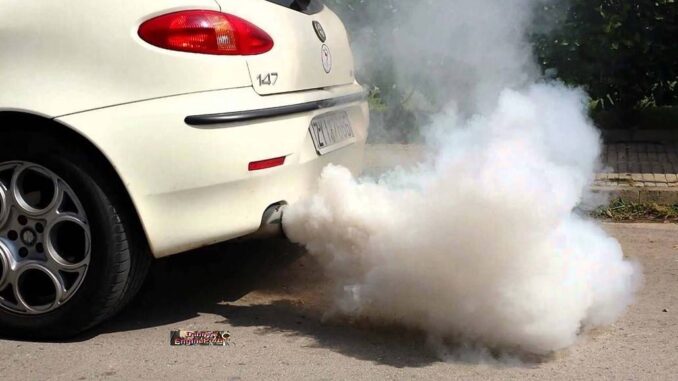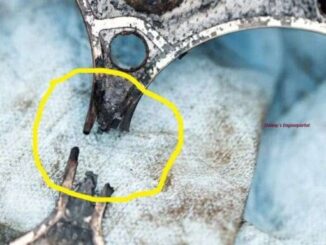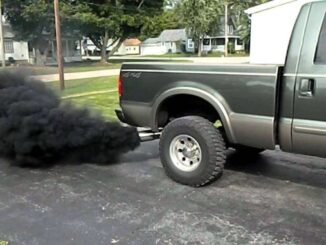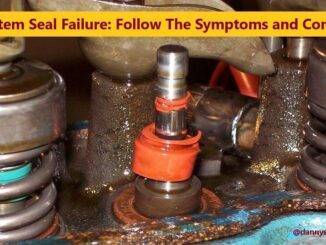
Seeing tailpipe smoke coming from your vehicle, is a sign your engine is not operating normally.
So, the first thing to do is, confirm the color of the tailpipe smoke. In other words, is it black, white or blue?
Because, the color of the tailpipe smoke, can help you determine, what the problem may be. Consequently, under normal driving conditions and idling, the tailpipe smoke should be transparent.
However, if the tailpipe smoke is a different color. Then, that is a clear sign that, something might not be working properly.
Even if your vehicle isn’t showing any warning lights, you still need to find the problem. This is just a warning sign, so solving it now, can save you money down the road. Likewise, there are many reasons, you may see tailpipe smoke coming from your vehicle.
No matter the reason, it’s a good idea, to get the vehicle checked and repaired, fast as possible.
Basically, There Are Three Common Colors, Of Tailpipe Smoke:
- Black
- White
- Blue
So, What Does The Color Mean
Black Tailpipe Smoke
- Check the adjustment and operation, of the automatic choke, if the engine is an older one with a carburetor.
- Check fuel pressure, if the engine is a newer one, with fuel injection.
Also, inspect the air filter, and check the (OBD) system, for any sensor fault codes. The (OBD) system, should detect a rich fuel condition. Then, set a fault code (such as P0172 or P0175) and turn on the (CEL).
Black tailpipe smoke on a vehicle with a gasoline engine, is a sign of a rich fuel mixture. (too much fuel, not enough air) A brief puff of black smoke, may be visible during hard acceleration, when the fuel mixture goes, momentarily rich.
If black smoke, is visible all the time. And, the inside of the tailpipe, is coated with heavy black carbon deposits. Then, it would tell you that the engine, has a rich fuel condition.
On an older vehicle with a carburetor, a rich fuel condition and black smoke, can be caused by:
- Stuck or misadjusted automatic choke.
- Leaky metal or hollow plastic float, inside the carburetor fuel bowl.
- This could include a fuel saturated foam plastic float, or an incorrectly adjusted float. (set too low)
- A plugged fuel filter, may also contribute to a rich fuel mixture.
A newer vehicle with fuel injection, black exhaust smoke, can be caused by:
- One or more, leaky fuel injectors.
- Too much fuel pressure. (sticking fuel pressure regulator)
- A faulty (MAF) sensor or (O2) sensor.
- A engine computer fault.
On diesel engines, black smoke in the exhaust, can occur during hard acceleration. But, if the engine continues to produce black smoke, the engine is getting too much fuel. The cause may be, incorrect injector timing or an injection control problem.
So, there is not enough air available, to burn all of the fuel. Then, some comes out as carbon particles, which are naturally black. Black smoking, is usually accompanied by a strong fuel smell. The engine will run poorly in this state, with reduced power and very poor economy.
White Tailpipe Smoke
The exhaust will have a slightly sweet smell, if the exhaust contains coolant. It could also have, a burned oil smell if it contains transmission fluid. Check the coolant level and the transmission fluid level. If the coolant is low and/or the engine has been overheating. Then, pressure test the cooling system, to see if it holds pressure. If it does not, the head gasket, is probably leaking and needs to be replaced.
When only the transmission fluid level is low, add the required fluid, to bring it back to the full mark. Inspect the vacuum hose from the transmission for fluid inside. If it is passing fluid, replace the vacuum modulator valve, on the transmission.
The causes of white tailpipe smoke can vary. However, it is common to see white exhaust smoke, when first starting a car, especially on cooler days. This is generally steam, caused by condensation. As the engine warms up and the condensation dissipates, the white exhaust smoke (steam) is no longer seen.
If excessive white exhaust smoke, is present well after the engine warms up. Then, it is necessary to have the car inspected, for possible internal coolant leaks. Indicators of an internal coolant leak include, white exhaust smoke. And, a sweet odor or a low coolant tank level.
An internal coolant leak, can also contaminate the engine oil, giving it a frothy, milky appearance. As a result, even small amounts of coolant entering the combustion chamber, will produce white exhaust smoke.
Some of the main causes of, white tailpipe smoke and coolant loss are:
- A cracked or warped, cylinder head.
- Cracked engine block.
- Head gasket failure, caused by overheating.
A cracked head may allow coolant to leak, into one or more cylinders. Dirty coolant, a poorly maintained cooling system, a low coolant level or a non-functioning cooling fan. Consequently, any one or more of these issues, can cause engine overheating. In addition, engine wear can eventually cause, the gaskets to lose their ability to seal, allowing internal coolant loss.
Intake manifold gasket and head gasket failures, are two of the most common sources of internal coolant loss.
Check for a low level in the coolant tank to determine, if coolant loss, is causing the white exhaust smoke. If the coolant tank is at the proper level, but excessive white exhaust smoke is present. Then, a cooling system pressure check, is required to determine where, if any, coolant leaks are located.
Blue Tailpipe Smoke
So, having blue tailpipe smoke, is bad news. Because, it means the engine is burning oil. And, usually smells, like burned toast. Check the oil level on the dipstick, to see if the engine is using oil. And, if the oil level is low, add oil as needed to bring it back to the full mark. DO NOT, let the engine oil level get too low or serious engine damage will result ! You can also do a compression test or leak down test, to diagnose worn pistons or rings.
The cause is usually:
- Worn valve guide seals or guides.
- Broken or worn, piston rings.
- Worn or damaged, cylinders.
Oil burning, can eventually contaminate the catalytic converter and (O2) sensor. It also increases, the risk of the engine running low on oil and losing oil pressure.
Accompanied by a bad smell, it may indicate that engine oil is getting into the combustion chamber. Although it is a hydrocarbon, like other fossil fuels, it does not burn well inside an engine. Therefore, much of the oil comes out of the tailpipe, in partially burned or unburned form.
The oil also carries contaminants from inside the engine, which undergo changes in the combustion process. Furthermore, leading to the creation of, smoking and bad smells. Really smoky vehicles, may use as much as 1 liter of oil every 200 km. Normal engines, however, burn little or no oil in 5000 km of driving.
Conclusion
So, if your exhaust, is sending up smoke signals, play it safe and find the problem, soon as possible. Because, your car may be trying to inform you of, an oil leak, broken part, clogged filter, or anything.
BY DANNY BENDER




